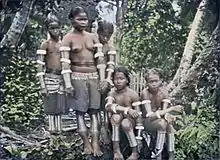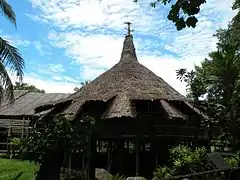Bidayuh
Bidayuh is the collective name for several indigenous groups found in southern Sarawak, Malaysia and northern West Kalimantan, Indonesia, on the island of Borneo, which are broadly similar in language and culture (see also issues below). The name Bidayuh means 'inhabitants of land'. Originally from the western part of Borneo, the collective name Land Dayak was first used during the period of Rajah James Brooke, the White Rajah of Sarawak. At times, they were also lesser referred to as Klemantan people.[3] They constitute one of the main indigenous groups in Sarawak and West Kalimantan and live in towns and villages around Kuching and Serian in the Malaysian state of Sarawak, while in the Indonesian province of West Kalimantan they are mainly concentrated in the northern Sanggau Regency. In Sarawak, most of Bidayuh population can be found within 40 km of the geographical area known as Greater Kuching, within the Kuching and Serian Division. They are the second-largest Dayak ethnic group in Sarawak after the Iban and one of the major Dayak tribes in West Kalimantan.
 | |
| Total population | |
|---|---|
| 205,900 (2014)[1] | |
| Regions with significant populations | |
| Borneo: | |
| 198,473 (2010)[2] | |
| n/a | |
| Languages | |
| Bidayuh languages: Bukar Sadong, Jagoi, Biatah (Siburan and Padawan), Malaysian/Indonesian and English language | |
| Religion | |
| Christianity (predominantly), Animism, Islam | |
| Related ethnic groups | |
| Bekati', Binyadu, Jongkang, Ribun, Selako, Lara', Sanggau, Sara', Tringgus, Semandang, Ahé | |
Settlement areas
Predominantly Bidayuh areas in Sarawak are Lundu, Bau, Penrissen, Padawan, Siburan, and Serian. Most of the Bidayuh villages can be found in the rural areas of Lundu, Bau, Padawan, Penrissen, and Serian district. The area continues up to the adjacent West Kalimantan border where they reside in Kembayan, Noyan, Sekayam, and Jangkang district in Sanggau Regency. The area in which they live is mainly in the basin of the Sarawak River and hilly to a mountainous forest, traditionally worked by rotational agriculture and hunting based around farms populated from parent villages situated on the hills for protection. Today, almost all the traditional longhouse villages have been replaced by individual houses, by roads and there are some plantation agriculture and a reduced emphasis on the growing of hill padi. Fruit trees, especially Durian, remain important property markers. The distinctive architectural and cultural feature of the Bidayuh is the head-house, now adopted as a symbol.
Languages
There are approximately 25 dialects of Bidayuh (Land Dayak) spoken in Sarawak, Malaysia, which can be grouped into four clusters of generally intelligible dialects: Eastern, Central, Highland, and Western.[4] In Sarawak, there are generally said to be three main linguistic groupings (Biatah language; Singai-Jagoi; Bukar Sadong language) but these can be broken down even beyond the list referenced below as most people can be distinguished by locals down to village level through smaller differences in vocabulary and intonation.[5] Each area speaks its own dialect:
- Lundu speaks Jagoi, Salako, and Lara.
- Bratak, Singai, Krokong, and Jagoi speak Singai-Jagoi.
- Penrissen speaks Bisitang while people in Kampung Bunuk speak Bunuk (Segu-Benuk).
- Siburan vicinity speaks Biatah.
- Bidayuhs who live around Serian such as Tebakang, Mongkos, Tebedu to Tanjung Amo near the border of Kalimantan Indonesia speak Sadong.
- Bidayuhs who live around Serian such as Baki, Baru, Taee, and Tarat speaks the Bukar language.
- Bidayuhs in Padawan speak several but related dialects like Bi-Annah, Pinyawa, Braang, Bia', Bisepug, and Emperoh/Bipuruh.
- Bidayuh Moden speaks mixed languages, mixed languages between Padawan and Jagoi language (Semeba, Tematu, Bumbok, and Sudad).
The dialects are not mutually intelligible and English or Malay are often used as common languages.
Linguistic issues
The Serian Bidayuhs have a distinct dialect known as the Bukar & Sadong language Bidayuh, which is not intelligible to Bidayuhs from other Districts. Here are some examples of the differences in the various dialects spoken in Serian, with their English and Malay equivalents. Also included are two Philippine languages, Kapampangan and Tagalog:
| English | Malay | Bukar & Sadong | Bau-Jagoi | Siburan-Padawan | Bra'ang-Pinyawa | Lundu (Salako) | Kapampangan | Tagalog |
|---|---|---|---|---|---|---|---|---|
| Father | Bapa | Amang | Sama | Sama | Sama' | Apak, Bapak | Ibpâ, (Bapa - Uncle) | Amang, Ama |
| Mother | Ibu | Andĕ/ayang | Sino | Sendo | Sin(d)o | Inuk, Indok, Umak, | Indû | Inang, Ina |
| Food | makanan | pima-an | pinguman | pimaan | Pinguman | Pamakanan | Pamangan | Pagkain |
| Rice | nasi | songkoi/sungkoi | tubi | tubi | Tubi | nasik | nasi | kanin |
| I | aku | aku | oku | Ěku | Ěku | aku | aku/I-aku | ako |
| You/thee | kamu/anda/engkau/kau | amu/akam | mu-u/ingan | ku-u/kaam | (K)u'u/ ka'am | kau | ika (sing.)/ikayu (pl.) | ikaw |
Religion and beliefs
_(14790143343).jpg.webp)
Bidayuhs are traditionally animist, and vestiges of these beliefs remain.[6] The Brooke Family era saw the arrival of Christian missionaries from 1848, bringing education and modern medicine, while a similar process also took place in Dutch Borneo on the Dutch controlled side. The great majority of Bidayuh are now Christians,[6] majority of them being Roman Catholic. Almost 70% of the people of Bidayuh have changed their traditional name to English name since they converted to Christianity and many young indigenous Bidayuh in Sarawak does not practice their traditional ceremonies anymore, weakening their culture as indigenous peoples of Sarawak. The Bidayuh people are the closest relative of the Melanau people and are said to have the same ancestor before splitting into different tribes. The original Bidayuhs are mainly Pagans or animists, however, at 50% has converted to Christianity.[7] They would have big festivals like the Gawai Dayak, which is a celebration to please the padi spirit for a good harvest.[8]
Most Bidayuh villages have either a Roman Catholic or Anglican church or a mosque. The Biatah people, who live in the Kuching area, are Anglican, while the people of the Bau area are Catholic.
Some renowned church also being established in some villages such as SIB (Sidang Injil Borneo) also called as Borneo Evangelical Church, Baptist Church, Assemblies Of God church, and other churches as SDA, Latter Rain.
The Bidayuh of Bukar has a unique tradition of hanging the bodies of the dead on trees and leaving them to rot away. The skeletons are left on trees as a reminder of the dead. The tradition is rarely done nowadays.[5]
Salako and Lara people
Although classified as "Bidayuh" by the Malaysian government, the Salako and Lara culture have little resemblance to other Bidayuh groups and their oral tradition claims different descent and migration histories. Linguistically, the Salako belong to another language family tree which is of the Malayic Dayak family (the same family as the Iban).[9] The Lara, although said to be more related to the Bidayuh (Jagoi-Singai), speak a language almost not mutually intelligible at all with the Bidayuh but belonged to the same language family tree which is the Land Dayak.[9] Even their customary rituals and rites differ from the other Bidayuhs (all Bidayuhs share almost the same ritual and customary rites).
Culture
.jpg.webp)
Musical heritage
The Bidayuh have a musical heritage consisting of various types of agung ensembles - ensembles composed of large hanging, suspended or held, bossed/knobbed gongs which act as a drone without any accompanying melodic instrument.[10][11]
Traditional dance
- Ngiyar[12]
Traditional cuisine
Several traditional Bidayuh dishes are:[13]
- Tempoyak goreng, fried fermented durian with pork and lemongrass condiment
- Rotung, sago cooked in bamboo
- Kubar, sweet sago pancakes
- Linut, sticky sago paste
- Manok pansoh, chicken and tapioca leaves cooked and served in a bamboo stalk[14][15]
- Tobah, preserved wild animal meat or pork, and fish[16]
Notable Bidayuhs
- Anding Indrawani Zaini, an Akademi Fantasia star, model, actor and singer. He is of mixed Melanau-Bidayuh parentage.[17]
- Bryan Nickson Lomas, former Malaysian national diving athlete. He was the youngest Malaysian athlete to qualify for 2004 Summer Olympics when he was 14.[18]
- Dewi Liana Seriestha, Miss World 2014 Top 25 and Miss Talent for Miss World Beauty Pageant. She is of mixed Bidayuh-Indonesian parentage.[19]
- James Dawos Mamit, former Malaysian cabinet deputy minister.
- Pandelela Rinong, Malaysian national diving athlete.
- Made Katib, former Anglican bishop of the Diocese of Kuching.
- Michael Manyin, Sarawak Minister.
- Richard Riot Jaem, Malaysian cabinet minister.
- Tony Eusoff, actor and model.[20]
- Venice Elphi, Malaysian football player, played for ATM FA.[21]
References
- "State statistics: Malays edge past Chinese in Sarawak". The Borneo Post. Archived from the original on 15 April 2016. Retrieved 15 April 2016.
- Saw Swee-Hock (2015). The Population of Malaysia (Second ed.). Institute of Southeast Asian Studies. ISBN 978-98-146-2036-9.
- M. J. Melalatoa (1995). Ensiklopedi Suku Bangsa Di Indonesia, Volume 1. Departemen Pendidikan dan Kebudayaan RI. OCLC 37396203.
- Calvin R. Rensch (2006). Rhythm in Bidayuh. SIL International.
- Shiv Shanker Tiwary & P.S. Choudhary (2009). Encyclopaedia Of Southeast Asia And Its Tribes (Set Of 3 Vols.). Anmol Publications Pvt. Ltd. p. 247. ISBN 978-81-261-3837-1.
- Lucas Chin & Valerie Mashman, ed. (1991). Sarawak cultural legacy: a living tradition. Society Atelier Sarawak. p. 21. OCLC 1027899014.
- Akhmad Saufi; Imanuella R. Andilolo; Norain Othman; Alan A. Lew, eds. (2016). Balancing Development and Sustainability in Tourism Destinations: Proceedings of the Tourism Outlook Conference 2015. Springer. p. 90. ISBN 978-98-110-1718-6.
- "GAWAI DAYAK FESTIVAL - Tourism Malaysia Corporate Site". www.tourism.gov.my. Retrieved 13 January 2021.
- Language Family Tree Archived 4 March 2007 at the Wayback Machine
- Mercurio, Philip Dominguez (2006). "Traditional Music of the Southern Philippines". PnoyAndTheCity: A center for Kulintang - A home for Pasikings. Retrieved 21 November 2006.
- Matusky, Patricia (1985). "An Introduction to the Major Instruments and Forms of Traditional Malay Music". Asian Music. 16 (2): 121–182. doi:10.2307/833774. JSTOR 833774.
- Pat Foh Chang (1995). The Land of Freedom Fighters. Ministry of Social Development. ASIN B0006FECIK.
- Rintos Mail (1 November 2015). "Serving up unique Bidayuh cuisine". The Borneo Post. Retrieved 6 March 2018.
- Tamara Thiessen (2008). Bradt Travel Guide - Borneo. Bradt Travel Guides. p. 247. ISBN 978-18-416-2252-1.
- The Rough Guide to Malaysia, Singapore & Brunei. Rough Guides UK. 2015. ISBN 978-02-412-3808-0.
- Patrick Rigep Nuek (2002). A Dayak Bidayuh community: rituals, ceremonies & festivals. Patrick Rigep Nuek. p. 12. ISBN 98-341-1500-8.
- SHOWBIZ: From reality show to musical theatre http://www.nst.com.my/node/24055
- "Bryan impi jadi jurulatih renang" (in Malay). Sinar Harian. 15 April 2013. Retrieved 21 September 2018.
- "Ex-Miss World contestant Dewi Liana's second single album in the works". Bernama. 17 July 2016. Retrieved 17 July 2016.
- "Lessons from East Malaysian storytellers". The Nut Graph. Archived from the original on 9 August 2016. Retrieved 11 July 2015.
- Shaiful Shamsudin (27 January 2017). "Venice arkitek kejayaan ATM benam MISC-MIFA" (in Malay). Stadium Astro. Retrieved 21 September 2018.
Notations
- Baruk Dayak
- Patrick Rigep Nuek (2002). The Dayak Bidayuh Community: Rituals, Ceremonies, and Festivals.
External links
- Ethnologue language tree
- The Bidayuh Language: Yesterday, Today and Tomorrow Book on the Bidayuh language available for purchase from SIL, or freely downloadable from SIL: free access
- Atur Simayang Mass: The Holy Eucharist in Bukar Anglican eucharistic liturgy digitised by Richard Mammana
| Wikimedia Commons has media related to Bidayuh people. |
.jpg.webp)

